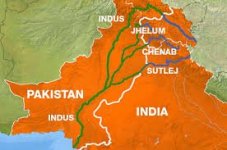India and Pakistan have had their complexities and still does to this day. There was a time when both the countries belonged to the same motherland but since 1947 it's been two of everything.
But, there's one things which has made a connecting thread between the two countries and it's the Indus river.
The Indus Water Treaty, signed on September 19, 1960, was a landmark agreement between India and Pakistan that regulates the use of the Indus River system's waters. Brokered by the World Bank, this treaty has been a cornerstone of water-sharing between the two nations, despite periods of tension and conflict.
A little background, The Indus River originates in Tibet and flows through India and Pakistan before emptying into the Arabian Sea. After the partition of India in 1947, disputes arose over the sharing of waters between the two countries. The treaty was negotiated over nine years, finally coming into effect on April 1, 1960.
Key Provisions:-
1)Water Allocation-The treaty allocates the waters of the three eastern rivers (Ravi, Beas, and Sutlej) to India and the three western rivers (Indus, Jhelum, and Chenab) to Pakistan. India receives 20% of the total water carried by the rivers, while Pakistan receives 80%.
2)Permitted Uses-India is allowed to use the waters of the western rivers for limited irrigation purposes and non-consumptive uses like hydroelectric power generation.
3)Permanent Indus Commission-A permanent commission was established to resolve disputes and ensure compliance with the treaty.
The Challenges and Disputes:-
Despite its success, the treaty has faced challenges and disputes over the years. Pakistan has raised concerns about India's construction of dams on the western rivers, which it claims could affect the water flow. India, on the other hand, asserts its right to use the waters for hydroelectric power generation and irrigation.
Let's talk about some recent developments about the thing, In April 2025, India suspended the treaty, citing national security concerns and Pakistan's alleged support for terrorism. This move has raised concerns about the treaty's future and the potential for water conflicts between the two nations.
The Indus Water Treaty has been a vital instrument in maintaining peace and cooperation between India and Pakistan, despite their complex and often contentious relationship. Its success has been hailed as a model for other transboundary water-sharing agreements worldwide.
But due to the recent activities by Pakistan at Pahalgam, India doesn't have any other way but to not continue with the treaty. Considering the heinous and terrifying deaths of Indians based on their religion, not continuing with the treaty is just not enough. Peace talks only work when both the parties follow through it.
To ensure the treaty's continued relevance, both countries must work together and Pakistan should really consider the things it has been a mother to like terrorism and hatred towards a religion different than theirs. Regular dialogue and cooperation through the Permanent Indus Commission can help resolve disputes but following through the decisions is what will make the really difference.
But, there's one things which has made a connecting thread between the two countries and it's the Indus river.
The Indus Water Treaty, signed on September 19, 1960, was a landmark agreement between India and Pakistan that regulates the use of the Indus River system's waters. Brokered by the World Bank, this treaty has been a cornerstone of water-sharing between the two nations, despite periods of tension and conflict.
A little background, The Indus River originates in Tibet and flows through India and Pakistan before emptying into the Arabian Sea. After the partition of India in 1947, disputes arose over the sharing of waters between the two countries. The treaty was negotiated over nine years, finally coming into effect on April 1, 1960.
Key Provisions:-
1)Water Allocation-The treaty allocates the waters of the three eastern rivers (Ravi, Beas, and Sutlej) to India and the three western rivers (Indus, Jhelum, and Chenab) to Pakistan. India receives 20% of the total water carried by the rivers, while Pakistan receives 80%.
2)Permitted Uses-India is allowed to use the waters of the western rivers for limited irrigation purposes and non-consumptive uses like hydroelectric power generation.
3)Permanent Indus Commission-A permanent commission was established to resolve disputes and ensure compliance with the treaty.
The Challenges and Disputes:-
Despite its success, the treaty has faced challenges and disputes over the years. Pakistan has raised concerns about India's construction of dams on the western rivers, which it claims could affect the water flow. India, on the other hand, asserts its right to use the waters for hydroelectric power generation and irrigation.
Let's talk about some recent developments about the thing, In April 2025, India suspended the treaty, citing national security concerns and Pakistan's alleged support for terrorism. This move has raised concerns about the treaty's future and the potential for water conflicts between the two nations.
The Indus Water Treaty has been a vital instrument in maintaining peace and cooperation between India and Pakistan, despite their complex and often contentious relationship. Its success has been hailed as a model for other transboundary water-sharing agreements worldwide.
But due to the recent activities by Pakistan at Pahalgam, India doesn't have any other way but to not continue with the treaty. Considering the heinous and terrifying deaths of Indians based on their religion, not continuing with the treaty is just not enough. Peace talks only work when both the parties follow through it.
To ensure the treaty's continued relevance, both countries must work together and Pakistan should really consider the things it has been a mother to like terrorism and hatred towards a religion different than theirs. Regular dialogue and cooperation through the Permanent Indus Commission can help resolve disputes but following through the decisions is what will make the really difference.

